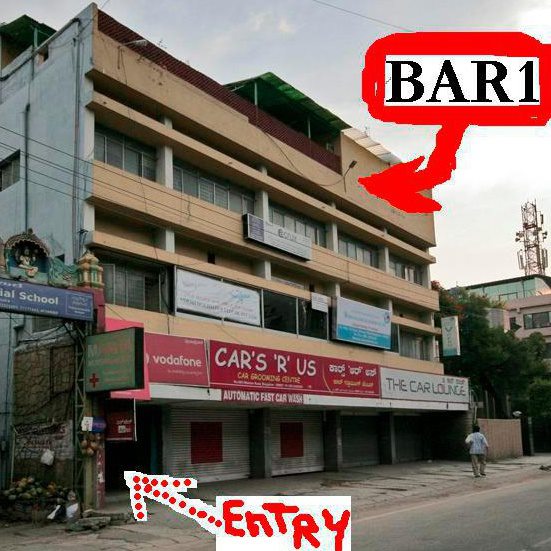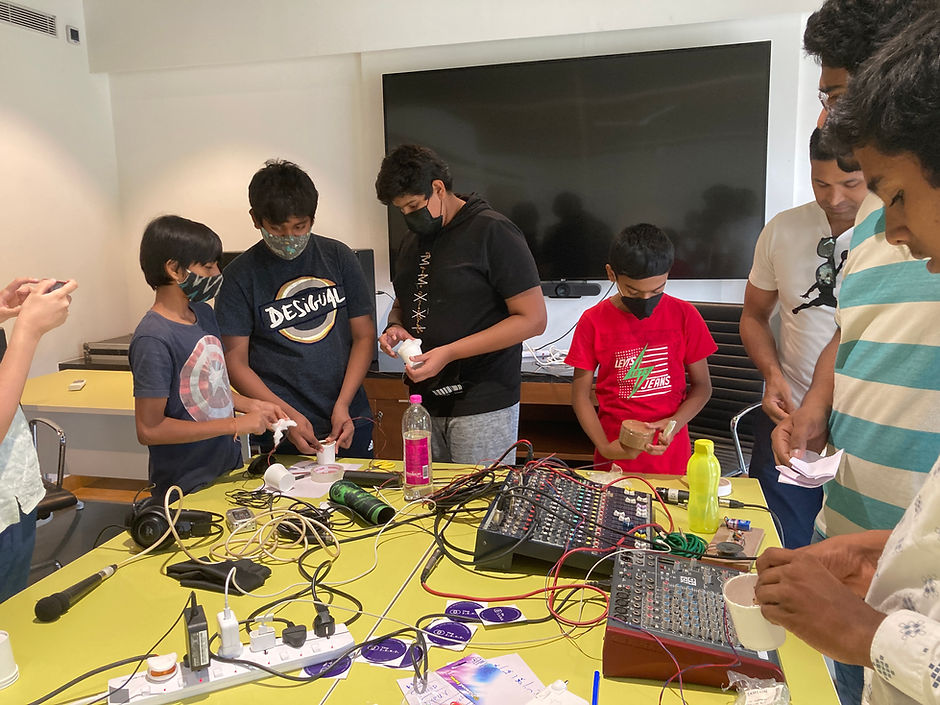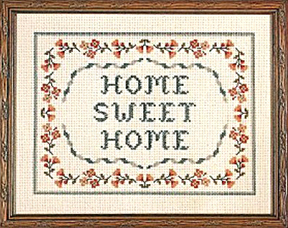An Eye for the In-Between Spaces
Joshua Muyiwa
Published on 30.12.2023

Photo courtesy: BAR1 team
The unofficial slogan of Bangalore, since the 90s, has been “swalpa adjust maadi”. Growing up in the city, at that time, it was either on everyone’s lips, t-shirts, or billboards. It’s a Kannada-English phrase that quite beautifully pins down the accommodative attitude of this city and its citizenry to adjust and adapt to the situation at hand. It addresses an ability to make do with the things around. It is this spirit that seemingly fuels the many artist-run initiatives that continue to mushroom in Bangalore.
In this essay, I use this spirit as a guide to trace the beginnings and the survival strategies of artist-run initiatives in this city—from the Bengaluru Artist Residency One (BAR1), which was started over two decades ago, to more recent players like the Pagal Canvas Backyard. I hope to understand the ways they work with the resources that individuals bring into these spaces. I also find that they aren’t invested in the perfect product, but far from it, these artist-run initiatives are interested in processes, personal practices, people, and the passing of ideas between these spheres.
One of the early examples of artist-run initiatives in the city was the artists-in-residence program put together by the Bengaluru Artist Residency One (BAR1), started in 2001. It was helmed by artists Ayisha Abraham, Smitha Cariappa, Suresh Kumar, Surekha Sharada, and Christoph Storz. “Initially, it was simply an exchange of artists between Aarau, Switzerland, and here [Bangalore],” recalls Suresh Kumar, who incredibly has been associated with a number of artist-run initiatives over the past two decades. He pieces together the origin story of this artists’ collective even before its actual formalization. “And it was possible because of [the Swiss artist] Christoph Storz, who is married to [the Bangalore artist] Sheela Gowda. Storz would spend half the year in Bangalore and half in Aarau, and had studios in both places, which he generously provided as artist spaces for this exchange to take place,” explains Suresh. Storz’s studio at Navaratna Apartments on 18th Cross in Malleshwaram, “an old-style apartment with a long-ish hall, which was used for the residents’ exhibitions—and the two bedrooms for the artists’ accommodation,” was the first brick-and-mortar location of BAR1.
In that first format, artists from Aarau and Bangalore were “democratically nominated” to work in the respective cities. Then along with the local artists, they might create or contemplate works using the tools and resources available to them within each of the contexts. “In those days, Bangalore was outside of the grid of international grants, residencies and exchange programs accessible to artists in the other Indian cities,” he points out. And so, while the Swiss artists were in the city for between three- and six-month periods, as part of their residency, they would hold workshops for local artists and students. “This was one of the major benefits of this exchange, it didn’t just help individual artists in the residency programs but brought something new to the city’s artist community as well,” Suresh adds.
“A few years into this informal artist exchange program, the Pro Helvetia New Delhi office was keen to support this already existing program, at which point, we decided to become a more formal organization and registered ourselves as the Bengaluru Artists Residency One (BAR1),” he recalls. And from their Malleshwaram studio they moved to their second physical location—a penthouse studio in an apartment building off Wheeler Road Extension in Cooke Town.
The influx of funding from the Swiss Arts Council afforded a formal side to BAR1’s residency programs, while the informal exchange of artists between Aarau and Bangalore continued alongside because of the understanding they had going. But with the funding fixed for a certain period of the year, it actually “became more challenging to run the space,” Suresh admits. “We had to generate money to run the space for the remainder of the year, and so it became difficult to host other local and national artists,” he explains. Here, they turned to the India Foundation for the Arts for a grant and started the ‘India-India Artists Residency’ for three years. In this version of BAR1, for six months, there would be Swiss artists, for three months, national artists, and for the remaining three months, a local artist. And while for the salons, talks, and open houses, they would use their official premises off Wheeler Road Extension, “for the shows, we would look for unconventional spaces; mostly abandoned buildings or houses just before they were demolished,” Suresh says, hinting at the many ways they continued to resist being entirely formal.
A little more than a decade into hosting artist residency programs, BAR1 would go on to experiment with its formats and functioning. They would change the focus of the artist they would host from time to time, which would shift the dynamics of the residency itself. “We weren’t looking for any kind of ‘legacy’ but wanted to create residency opportunities that were relevant to the needs of the local artist community,” he says of their motivation. This willingness to make modifications to their various programs and not hold on to their successes was “because the members of BAR1 were practicing artists who would constantly meet, talk, and think through all of these details.”
With BAR1’s Karnataka-Karnataka Artists Residency program, they would choose to completely abandon the written application method [still used for all artist residency programs] and instead the collective’s artists traveled over a couple of months to a number of art colleges across Karnataka. “Here, we gave artist talks, presentations, and workshops; and then spent a couple of days speaking to the interested artists who had shown up to the events. Casually, we would propose the idea of the residency and see if they are interested at all,” he says, speaking of the different approaches to selecting artists for their residency programs. “And the focus with this residency was also women artists, and that was the other added layer, trying to explain to the parents the concept of artist-in-residence. To their parents, it sounded like we were bringing their daughters to a hotel,” he says, and laughs. And in these instances, the women artists of the collective would meet and engage with the families of the interested women artists and address each of their concerns. It wasn’t always a success, but Suresh claims that this direct approach did work in more than a few instances. The artists behind BAR1 understood that they would have to explain the idea of an artist residency program as well as remove the hurdle of writing a proposal for artists and art students from other cities and towns in Karnataka if they were going to reach them at all. These kinds of significant choices in their execution and functioning demonstrate BAR1’s agility to move between formal, funded processes and more flexible one-on-one interventions to find the artists for their programs.
Another artist-run initiative that emerged around the same time is 1Shanthiroad Studio/Gallery. In 2003, the artist Suresh Jayaram transformed his private family home into a public open studio/gallery for the city’s artists to experiment and exhibit their work. From its early days, 1Shanthiroad injected an easy informality into the local art scene. It was thoughtfully created by the architect Meeta Jain and Jayaram to mold and make the space available for its many requirements. From just dropping in for a free meal that transformed into thoughtful, intelligent conversations on art and practice, to showcasing students’ works, to becoming a hub for local artists to present their work before shows in other cities or after their stints at international artist residencies, this space would, and could make room for all of it.
Over the past two decades, it has grown into a more formal, active host for a range of residency programs that showcase local, national, and international artists. But it still maintains its inflection of informality. Through its programs, it has built long-term relationships with foreign cultural institutions, which have further created opportunities for individual artists and the local artist community as a whole. 1Shanthiroad Studio/Gallery also addressed this problem of temporality with regard to artist-run initiatives with Jayaram’s opening up of his private property for public access.
This lack of availability of or the formidable expenses involved in maintaining a brick-and-mortar artist space outside of formal government and gallery systems has constantly plagued Bangalore’s artist-run initiatives. In 2009, artists Suresh Kumar, Archana Prasad, and Shivaprasad S launched Samuha: Artist Initiative and Collective as a fixed, short-term solution to this problem of real estate. After seven months of extensive talks with artists, critics, and curators; art schools—administrators and students; and galleries across the city, this project acted as “a neutral common ground for sharing and learning from peers and seniors” for the city’s art community. Samuha didn’t focus on residencies at all, but instead brought together artists of varying levels of experience and expertise, as well as resources, tools, and materials into a shared physical space.
Starting from June 22, 2009, it ran for 414 days on the first floor of the ADA Rangamandira on JC Road. Samuha figured out a financial model to keep this space running—every one of the 23 members paid a fixed rate for 12 months, and this allowed them ownership of the common space for a fixed number of days each year. During the course of their ownership, the artist was allowed to do anything they wanted with the space. Member artists used the slot to make presentations, conduct workshops, and hold talks. They displayed their own personal works across disciplines from painting and sculpture to new media arts and performance, besides curating group shows of peers and younger practitioners from across the city, state, and country.It acted as a central, common space for artists—young and experienced—to showcase work in the context of their own city, for their communities, and with the support of their peers.



While these artist-run initiatives addressed systemic problems related to funding and featuring artists, others sprang up to speak to the changing, explorative personal practices of local artists. Around the early 2000s, Bangalore’s importance as a technology and science hub gained prominence, and not surprisingly, this began to reflect in the personal practices of some local artists. In 2006, the artist-run sound research laboratory called the Indian Sonic Research Organisation (ISRO) was one such initiative, co-founded by artist Yashas Shetty. The name is both an in-joke and “a nod to the serious research work undertaken at the laboratory,” says Shetty, surrounded by sound equipment and electronics at his home studio. “At ISRO, we build instruments—both software and hardware; host workshops for teachers, students, and the general public; organize performances and concerts, and artist residences. We do a lot of research, which we publish in different forums, which includes written work or exhibitions. We archive. And as of last year, we run a publishing house for musicians called ISSAI,” he says, painting the broad strokes of this organization grounded in the intersection between sound, tech, and art.
 Italian composer, sound artist and performer Alessandro Olla leading a "Field Recordings as a Compositional Tool" workshop for ISRO, 2023
Italian composer, sound artist and performer Alessandro Olla leading a "Field Recordings as a Compositional Tool" workshop for ISRO, 2023Photo Courtesy:The Indian Sonic Research Organisation (ISRO)
Another example of an initiative at these crossroads was Jaaga, started in 2009. From a pallet racking, modular, temporary structure on a piece of land in Richmond Town offered by city-based architect Naresh Narasimhan on the condition that it be vacated on request, it has grown into a more permanent, collaborative space that works between coding and creativity. Lately, they’ve been working at the intersections between artificial intelligence (AI) and climate change solutions, and recently co-hosted FutureFantastic, a tech-art festival with a similar focus; they have also been working on Dara.Network, a carefully curated directory of creators across the country and the UK, before going global.
These organizations continue to survive because of the strategies they adopt to build communities around themselves. For Jaaga, the city’s new bustling technology scene opened up different modes of engagement with the city. On the other hand, ISRO, though working with new media and technologies, has grown in strength over the past 17 years tapping into another precious resource of the city: goodwill. “When we didn’t have living spaces for our artists-in-residence, then other artists in the city provided space. And this kind of making things happen on the go is an enormous part of keeping an artist-run initiative alive and running,” he says. For Shetty, the “aesthetic” of this mode of functioning “where one draws on one’s social capital” is a more appealing path. And this ensures that the organization practices some kind of resistance to contemporary neoliberal ideas. And this isn’t just at the organizational level of ISRO; it subverts these ideas at the production level too: “through the stuff that we make, where we show, and how we show it.” While it might be ideal for artist-run spaces “to have shitloads of money,” says Shetty, for him and others behind these initiatives that has never been the driver of their intentions; instead “it has always been about pursuing a certain set of ideas.”
These ‘certain ideas’ planted by early artist-run initiatives in the city have molded the ideologies that drive those that continue to shape the landscape of art and its practices today. BAR1 played with and pushed the parameters of the artist-residency model to find and fund the practices of local artists. It also brought newer, fresher knowledge-sharing systems into the community and the city. 1Shanthiroad Studio/Gallery blurred the lines between the private and the public, providing an inviting space for showcasing works and works-in-progress of artists across a range of experiences. Samuha challenged the exhibition model, and even self-financed this initiative, as a means to subvert gallery systems. ISRO has straddled the path between grants and goodwill to keep its programs running.
It is interesting and heartening to see that Bangalore continues to be a fertile ground for community-centered initiatives. And the city continues to attract artists willing to try something out, adapting previously practiced survival strategies from their predecessors and adding their own contexts into the mix to find their own way.


[L] One of Pagal Canvas’s comic books drying out after being screen printed at the studio. Photo courtesy: Biplab Mahato.
[R] Mohit Mahato mixing chemicals for a cyanotype workshop at the studio.
Photo courtesy: Biplab Mahato.
Pagal Canvas Backyard is one such young, artist-run initiative that has learned from these predecessors to translate private desires and personal practices into the public domain. Artist and co-founder Mohit Mahato wanted to take his love for bookmaking and create something that brought different practitioners into the same fold. Like other artist-run initiatives in the city, Pagal Canvas Backyard works on the principles of openness to collaboration, the ability to adapt to situations, and the desire to be a space for showcasing new and exciting work. It marks an evolution from these previous spaces by way of its medium of dissemination and means of financing itself. “There was a growing zine culture in the city when we started this platform as students of Karnataka Chitrakala Parishath. Essentially, we began to use zines as a ‘group show’ to put together and present the already-existing works of our peers and juniors from the college,” he says. And since the goal was always to sell these zines, so that the process could fund itself, they had to keep costs low. “We settled on using Xerox, then we would buy the paper, do the cutting, folding and pinning—and slowly, other people joined us and a community grew,” he says. “Artists also saw the positive in using the new medium to showcase their works because it began to act as a pocket portfolio for their works instead of carrying around their canvases. And the booklet format allowed them to send around their work too,” he adds. The audiences of the zines—initially, the student body of the college—were happy to have artworks that they could not only afford to buy, but also tear up and put up as posters on their walls.
Over their five years of operation, this artist collective has organically grown its relationships and resources from strength to strength in the service of its fundamental motivation to “build a community through producing printed material and circulating them.” They also supplement their income through producing and marketing their merchandise “which always features works by local artists” or take up commercial, commissioned assignments “that allows them to pay some of their overhead bills.”
Artists who call this city their home have had the tendency to happily move between mainstream and alternative realms. In fact, this seems to be an important feature of the city’s artist-run spaces. There continues to be a freedom to move between spaces, to learn from both, and then to adopt and adapt these lessons. This approach seems to simultaneously grow both ends of the spectrum, while also allowing for the discovery of the potential and possibilities in the in-betweens. A flair for these skills is something that Bangalore’s artist-run initiatives consistently illuminate.
Joshua Muyiwa is Bangalore-based poet, performer and freelance writer. He can be reached at joshua.muyiwa@gmail.com .
